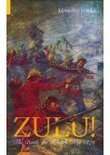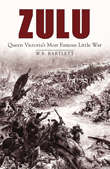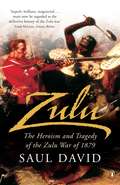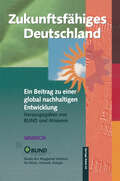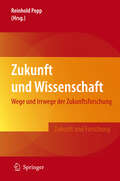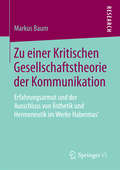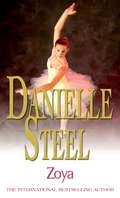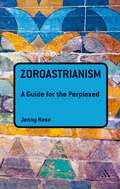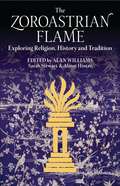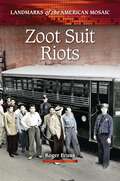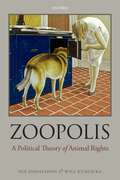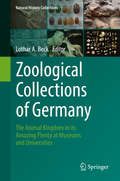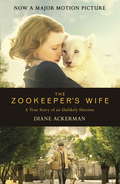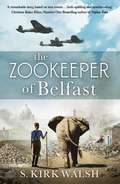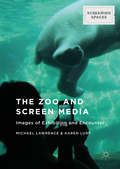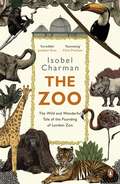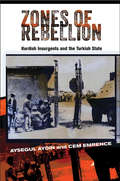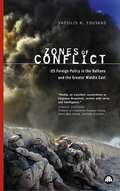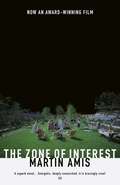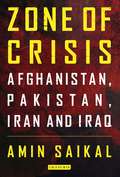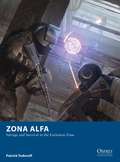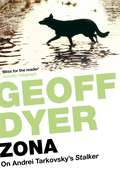- Table View
- List View
Zulu! The Battle for Rorke's Drift: The Battle For Rorke's Drift 1879
by Edmund YorkeFought on the night of 22/23 January 1879 and immortalised in the film epic Zulu, Rorke's Drift represented one of the most glorious, if subsequently controversial episodes in British military history. For twelve desperate hours, outnumbered by over 25-1, barely 140 British soldiers, based at the remote mission station of Rorke's Drift, South Africa, were locked in a ferocious life or death struggle with over 4000 seasoned warriors of the hitherto victorious Zulu Army - the most powerful indigenous African army. Only hours earlier, in the shadow of the ominous Sphinx-like Isandlwana Crag, other elements of this same Zulu force had virtually annihilated a 1700-strong British colonial force - one of the greatest defeats of Queen Victoria's reign. In the wake of this massacre, the survival of the British Empire in South Africa rested with the tiny garrison of Rorke's Drift.
Zulu: Queen Victoria's Most Famous Little War
by W B BartlettThe Zulu War grabs attention in a way that no other of Queen Victoria's "Little Wars" does. It is a story rich in the extremes of human experience: gallantry, cowardice, savagery, hubris, and sheer, stark terror amongst others. The way the campaign unfolded was a consequence of the actions of Britain's commander in the field, Lord Chelmsford, who thought that the outcome would be a foregone conclusion, but then found himself faced with one of the most shocking disasters in British military history. This book looks at events through Chelmsford's eyes, examining contemporary correspondence to tell the tale. Forced to cope with the catastrophe of Isandlwana, only slightly offset by the heroic defense of Rorke's Drift, he then had to win the war as quickly as possible, before the man who had been chosen to replace him arrived in South Africa. Full of drama, this is the story of Lord Chelmsford's war, one of the most turbulent campaigns ever fought in Africa.
Zulu: The Heroism and Tragedy of the Zulu War of 1879
by Saul DavidThe Zulu War of 1879 was the most brutal and controversial British imperial conflict of the 19th century. Saul David is presenting a programme on the subject which will be aired in October 2003. He is using research from that to compile this book. The programme will hopefully raise awareness of this young historian's name and of the subject matter.
Zukunftsfähiges Deutschland: Ein Beitrag zu einer global nachhaltigen Entwicklung
by Reinhard Loske Raimund BleischwitzDeshalb haben sich die Umweltorganisationen Bund für Umwelt und Naturschutz Deutschland (BUND) und die Organisation der Entwick lungszusammenarbeit MISEREOR zusammengetan und gemeinsam beim Wuppertal Institut für Klima, Umwelt, Energie die Studie Zukunftsfähiges Deutschland - ein Beitrag zu einer global nachhaltigen Entwicklung in Auf trag gegeben. Mit der Vorstellung der Forschungsergebnisse wollen die Auftraggeber nicht ein neu es "Modell Deutschland" propagieren. Es geht vielmehr darum, der Frage nachzugehen, wie das Leben in einem "Zukunfts fähigen Deutschland" aussehen könnte, wenn nachhaltige Entwicklung mehr sein soll als Bestandteil der Rhetorik internationaler Konferenzen und politischer Sonntagsreden. Die Studie vereint verschiedene Themenfelder: Es werden die Grenzen der ökologischen Belastbarkeit benannt, Umweltziele formuliert, Reduktions ziele errechnet und schließlich Wege aufgezeigt, wie diese Ziele erreichbar sind. Doch der Kern der Studie sind die Leitbilder. Sie umreißen Antworten auf grundlegende Fragen, die in der tagespolitischen Diskussion vergessen werden. Wie kann sich ein demokratisch verfaßter Industriestaat so verän dern, daß ökologische Grenzen eingehalten werden? Daß die Verhältnisse zwischen Nord und Süd gerechter werden? Welche politischen und wirt schaftlichen Rahmenbedingungen sind nötig? Die Studie macht deutlich: Ein "gutes Leben" ist nicht abhängig von stei gendem Bruttosozialprodukt, wachsenden Stoffströmen und immer höhe rem Energieverbrauch. Sie zeigt das Mögliche auf, Alternativen zu "Vor wärts in den Abgrund" und "Zurück in die Steinzeit". Zweifellos bleiben noch offene Fragen. Manches wird Widerspruch auslösen. Aber die Studie zeigt Perspektiven für eine lebenswerte Zukunft und eine globale Partner schaft auf, für die es sich lohnt, technischen Erfindungsgeist und soziale Kreativität einzusetzen.
Zukunft und Wissenschaft: Wege und Irrwege der Zukunftsforschung (Zukunft und Forschung)
by Reinhold PoppWissenschaftlich fundierte Zukunftsforschung findet insbesondere im deutschsprachigen Raum nur vereinzelt statt. In Deutschland, Österreich und der Schweiz gibt es insgesamt nur drei Hochschulen mit Professuren für Zukunftsforschung – dem steht jedoch eine wachsende Zahl von Unternehmensberatern und Trend-Gurus gegenüber, die sich selbst als Zukunftsforscher bezeichnen. Die Autoren des Sammelbands beschäftigen sich in ihren Beiträgen systematisch mit den bislang vernachlässigten wissenschaftlichen Grundlagen der Zukunftsforschung.
Zu einer Kritischen Gesellschaftstheorie der Kommunikation: Erfahrungsarmut und der Ausschluss von Ästhetik und Hermeneutik im Werke Habermas’
by Markus BaumMarkus Baum widmet sich zweier Begründungs- und Theorieformen: der Kommunikationstheorie Habermas’ und der älteren Kritischen Theorie. Sein Ziel ist es, aufzuzeigen, dass der Anspruch der Theorie des kommunikativen Handelns nur zu erfüllen ist, wenn spezifische Intentionen der älteren Kritischen Theorie in den Rahmen der Theorie Habermas’ überführt werden. Von dieser Diskussion ausgehend werden die Methode der hermeneutischen Interpretation, der Begriff des sozialen Kampfes und der Bereich des Ästhetischen behutsam im Paradigma der Intersubjektivität verortet, sodass sie nicht in Widerspruch zu dessen axiomatischen Annahmen geraten. Die Rückgewinnung der Intentionen der älteren Kritischen Theorie bahnt den Weg zu einer Kritischen Gesellschaftstheorie der Kommunikation.
Zoya: An epic, unputdownable read from the worldwide bestseller (Bestseller Oro Ser. #Vol. 245)
by Danielle SteelTHE WORLD'S FAVOURITE STORYTELLERNEARLY ONE BILLION COPIES SOLD One woman's odyssey through a century of turmoil . . . St Petersburg: one famous night of violence in the October Revolution ends the lavish life of the Romanov court forever - shattering the dreams of young Countess Zoya Ossupov.Paris: under the shadow of the Great War, émigrés struggle for survival as taxi drivers, seamstresses and ballet dancers. Zoya flees there in poverty - and leaves in glory.America: a glittering world of flappers, fast cars and furs in the Roaring Twenties; a world of comfort and café society that would come crashing down without warning. An epic and romantic tale from one of the best-loved writers of all time. Perfect for fans of Penny Vincenzi, Lucinda Riley and Maeve BinchyPRAISE FOR DANIELLE STEEL:'Emotional and gripping . . . I was left in no doubt as to the reasons behind Steel's multi-million sales around the world' DAILY MAIL'Danielle Steel is undeniably an expert' NEW YORK TIMES
Zoroastrianism: A Guide for the Perplexed (Guides for the Perplexed)
by Jenny RoseThe significance of the Zoroastrian religion in the development of the history of thought is often only mentioned in passing, or is completely overlooked. Zoroastrianism has developed over a span of at least three thousand years, with roots in a common Indo-Iranian culture and mythology, then becoming part of imperial Iranian ideology within an Ancient Near Eastern setting, and emerging in variant forms in western and central Asia in late antiquity. The religion continues as a living faith for an estimated 130 - 150,000 adherents in the world.Most Zoroastrians if asked, 'In a nutshell, what do Zoroastrians believe?' would begin their answer with the moral maxim: 'Good Thoughts, Good Words, Good Deeds.' Zoroastrianism: A Guide for the Perplexed takes this foundational trifold ethic as the framework for its three main chapters. The book presents a comprehensive study of the religion through its focus on the questions that perplexed seekers might ask of a Zoroastrian concerning ideology and ethics; current discussions of 'text' and 'author'; and the putting-into-practice of the religion.
Zoroastrianism: A Guide for the Perplexed (Guides for the Perplexed)
by Jenny RoseThe significance of the Zoroastrian religion in the development of the history of thought is often only mentioned in passing, or is completely overlooked. Zoroastrianism has developed over a span of at least three thousand years, with roots in a common Indo-Iranian culture and mythology, then becoming part of imperial Iranian ideology within an Ancient Near Eastern setting, and emerging in variant forms in western and central Asia in late antiquity. The religion continues as a living faith for an estimated 130 - 150,000 adherents in the world.Most Zoroastrians if asked, 'In a nutshell, what do Zoroastrians believe?' would begin their answer with the moral maxim: 'Good Thoughts, Good Words, Good Deeds.' Zoroastrianism: A Guide for the Perplexed takes this foundational trifold ethic as the framework for its three main chapters. The book presents a comprehensive study of the religion through its focus on the questions that perplexed seekers might ask of a Zoroastrian concerning ideology and ethics; current discussions of 'text' and 'author'; and the putting-into-practice of the religion.
The Zoroastrian Flame: Exploring Religion, History and Tradition (Library Of Modern Religion Ser.)
by Alan Williams Sarah Stewart Almut HintzeZoroastrianism has always commanded interest way beyond the circles of its actual adherents. Its unbroken history, remarkable texts and distinctive beliefs span three millennia, making it one of the world's most venerable faiths. For many centuries, from the birth of the religion late in the second millennium BC to its influence on the Achaemenids and later adoption in the third century AD as the state religion of the Sasanian Empire, it enjoyed imperial patronage and profoundly shaped the culture of antiquity. The Magi of the New Testament most probably were Zoroastrian priests from the Iranian world, while the enigmatic figure of Zarathushtra (or Zoroaster) himself has exerted continual fascination in the West, influencing creative artists as diverse as Voltaire, Nietzsche, Mozart and Yeats. This authoritative volume brings together internationally recognised scholars to explore Zoroastrianism in all its rich complexity. Examining key themes such as history and modernity, tradition and scripture, art and architecture and minority status and religious identity, it places the modern Zoroastrians of Iran, and the Parsis of India, in their proper contexts. The book extends and complements the coverage of its companion volume, The Everlasting Flame.
Zoot Suit Riots (Landmarks of the American Mosaic)
by Roger BrunsThe Zoot Suit Riots in 1943 and the infamous Sleepy Lagoon murder trial of the preceding year represent a turning point in the cultural identity and historical experience of Mexican Americans in the United States. This engaging study of these regrettable events provides context for understanding the continuing battles in the 21st century over immigration policy and race relations.Although the "zoot suit" had earlier been a black youth fashion trend identified with jazz culture, by the 1940s, the zoot suit was adopted by Mexican American teenagers in wartime Los Angeles, who wore it as their unofficial "uniform" as an act of rebellion and to establish their cultural identity. For a week in June of 1943, the Zoot Suit Riots, instigated by Anglo-American servicemen and condoned by the Los Angeles police, terrorized the Mexican American community. The events were an ugly testament to the climate of racial tension and resentment in Los Angeles—and after similar riots began across the nation, it became apparent how endemic the problem was. This book traces these important historic events and their subsequent cultural and political influences on the Mexican American experience, especially the activist and reform efforts designed to prevent similar future injustices.General readers will gain an understanding of the challenges facing the Mexican American community in wartime Los Angeles, grasp the racial and cultural resistance of the larger Anglo-American society of the time, and see how the blatant injustices of the Sleepy Lagoon trial and the Zoot Suit Riots served to galvanize Latinos and others to fight back. Those conducting in-depth research will appreciate having access to original materials sourced from Federal and state archives as well as newspapers and other repositories of information provided in the book.
Zoot Suit Riots (Landmarks of the American Mosaic)
by Roger BrunsThe Zoot Suit Riots in 1943 and the infamous Sleepy Lagoon murder trial of the preceding year represent a turning point in the cultural identity and historical experience of Mexican Americans in the United States. This engaging study of these regrettable events provides context for understanding the continuing battles in the 21st century over immigration policy and race relations.Although the "zoot suit" had earlier been a black youth fashion trend identified with jazz culture, by the 1940s, the zoot suit was adopted by Mexican American teenagers in wartime Los Angeles, who wore it as their unofficial "uniform" as an act of rebellion and to establish their cultural identity. For a week in June of 1943, the Zoot Suit Riots, instigated by Anglo-American servicemen and condoned by the Los Angeles police, terrorized the Mexican American community. The events were an ugly testament to the climate of racial tension and resentment in Los Angeles—and after similar riots began across the nation, it became apparent how endemic the problem was. This book traces these important historic events and their subsequent cultural and political influences on the Mexican American experience, especially the activist and reform efforts designed to prevent similar future injustices.General readers will gain an understanding of the challenges facing the Mexican American community in wartime Los Angeles, grasp the racial and cultural resistance of the larger Anglo-American society of the time, and see how the blatant injustices of the Sleepy Lagoon trial and the Zoot Suit Riots served to galvanize Latinos and others to fight back. Those conducting in-depth research will appreciate having access to original materials sourced from Federal and state archives as well as newspapers and other repositories of information provided in the book.
Zoopolis: A Political Theory of Animal Rights
by Sue Donaldson Will KymlickaZoopolis offers a new agenda for the theory and practice of animal rights. Most animal rights theory focuses on the intrinsic capacities or interests of animals, and the moral status and moral rights that these intrinsic characteristics give rise to. Zoopolis shifts the debate from the realm of moral theory and applied ethics to the realm of political theory, focusing on the relational obligations that arise from the varied ways that animals relate to human societies and institutions. Building on recent developments in the political theory of group-differentiated citizenship, Zoopolis introduces us to the genuine "political animal". It argues that different types of animals stand in different relationships to human political communities. Domesticated animals should be seen as full members of human-animal mixed communities, participating in the cooperative project of shared citizenship. Wilderness animals, by contrast, form their own sovereign communities entitled to protection against colonization, invasion, domination and other threats to self-determination. `Liminal' animals who are wild but live in the midst of human settlement (such as crows or raccoons) should be seen as "denizens", resident of our societies, but not fully included in rights and responsibilities of citizenship. To all of these animals we owe respect for their basic inviolable rights. But we inevitably and appropriately have very different relations with them, with different types of obligations. Humans and animals are inextricably bound in a complex web of relationships, and Zoopolis offers an original and profoundly affirmative vision of how to ground this complex web of relations on principles of justice and compassion.
Zoological Collections of Germany: The Animal Kingdom in its Amazing Plenty at Museums and Universities (Natural History Collections)
by Lothar A. BeckThis book is devoted to the knowledge of up to 250 years of collecting, organizing and preserving animals by generations of scientists. Zoological Collections are a huge resource for modern animal research and should be available for national and international scientists and institutions, as well as prospective public and private customers. Moreover, these collections are an important part of the scientific enterprise, supporting scientific research, human health, public education, and the conservation of biodiversity. Much of what we are beginning to understand about our world, we owe to the collection, preservation, and ongoing study of natural specimens. Properly preserved collections of marine or terrestrial animals are libraries of Earth's history and vital to our ability to learn about our place in its future.The approach employed by the editor involves not only an introduction to the topic, but also an external view on German collections including an assessment of their value in the international and national context, and information on the international and national collection networks. Particular attention is given to new approaches of sorting, preserving and researching in Zoological Collections as well as their neglect and/or threat. In addition, the book provides information on all big Public Research Museums, on important Collections in regional Country and local District Museums, and also on University collections.This is a highly informative and carefully presented book, providing scientific insight for readers with an interest in biodiversity, taxonomy, or evolution, as well as natural history collections at large.
The Zookeeper's Wife: An unforgettable true story, now a major film (Thorndike Biography Ser. #0)
by Diane AckermanIn war-torn Warsaw, a zookeeper and his wife refuse to surrender... Now a major motion picture starring Jessica Chastain and Daniel Brühl, Diane Ackerman's The Zookeeper's Wife is based on a remarkable true story of bravery and sanctuary during World War II. Perfect for fans of Lion and Hidden Figures. 'I can't imagine a better story or storyteller. The Zookeeper's Wife will touch every nerve you have' -Jonathan Safran Foer, author of Everything is Illuminated When Germany invades Poland, Luftwaffe bombers devastate Warsaw and the city's zoo along with it. With most of their animals killed, or stolen away to Berlin, zookeepers Jan and Antonina Zabinski begin smuggling Jews into the empty cages.As the war escalates Jan becomes increasingly involved in the anti-Nazi resistance. Ammunition is buried in the elephant enclosure and explosives stored in the animal hospital. Plans are prepared for what will become the Warsaw uprising. Through the ever-present fear of discovery, Antonina must keep her unusual household afloat, caring for both its human and animal inhabitants - otters, a badger, hyena pups, lynxes - as Europe crumbles around them.Written with the narrative drive and emotional punch of a novel, The Zookeeper's Wife is a remarkable true story. It shows us the human and personal impact of war - of life in the Warsaw Ghetto, of fighting in the anti-Nazi resistance. But more than anything it is a story of decency and sacrifice triumphing over terror and oppression. What readers are saying about The Zookeeper's Wife: 'Beautifully and sensitively written - a must read''An adventure that inspires''Both horrifying and endearing on a scale I've not experienced in years''A story that will haunt you forever''Haunting, life affirming, sad, and inspiring'
The Zookeeper of Belfast: A heart-stopping novel based on the incredible true story of the woman who saved a baby elephant from Belfast Zoo during the Blitz
by S. Kirk WalshAs the bombs rain down on the city, Belfast's first ever female zookeeper must fight to save the baby elephant in her charge in this gripping, uplifting tale based on a true story.1941. With the men away fighting, animal-lover Hettie Quin is made Belfast Zoo's first ever female zookeeper. She is put in charge of Violet, a three-year-old Indian elephant, and they soon form a special bond. With Violet at her side, Hettie can almost escape the grim reality of her life: the father who has abandoned her family; the sister who recently died; the war that's raging hundreds of miles away.But the devastation of war is closer than she thought. When the bombs begin to rain down on the city, Hettie must gather all her courage to protect those she loves the most. Can she save Violet - and get through unscathed herself?Based on a true story, The Zookeeper of Belfast is a gripping and uplifting tribute to what one woman's courage and tenacity can achieve in the most dire of circumstances - perfect for fans of Heather Morris, Natasha Lester, Kate Furnivall, Mandy Robotham and Fiona Valpy.Praise for THE ZOOKEEPER OF BELFAST:'Walsh delivers a turbulent portrait of life in a divided city . . . A unique perspective of a country at war and the lengths people will go for those they love.' - Kirkus Reviews'Sensitively rendered and finely drawn, this remarkable story, based on true events, is both uplifting and heartbreaking.' - Christina Baker Kline, #1 New York Times bestselling author of Orphan Train'Walsh has written a novel of deep affection and knife-edge suspense. A brilliant debut.' - Margot Livesey, author of The Boy in The Field'An elephant, a young zookeeper, the city of Belfast, bombings, and an IRA member are the improbable characters in this captivating and intimately felt novel that tells the story of a young woman's uncommon devotion and courage under fire.' - Lily Tuck, author of Sisters'A zoo in wartime Belfast and a young woman's fierce love for the elephant in her care come vividly to life in this beautiful, beguiling, and atmospheric debut novel.' - Dominic Smith, author of The Last Painting of Sara de Vos·Cinematic in scope and brimming with emotion, this is a soaring work of historical imagination.' - Karen Olsson, author of All the Houses
The Zoo and Screen Media: Images of Exhibition and Encounter (Screening Spaces)
by Michael Lawrence Karen LuryThis book is the first critical anthology to examine the controversial history of the zoo by focusing on its close relationship with screen media histories and technologies. Individual chapters address the representation of zoological spaces in classical and contemporary Hollywood cinema, documentary and animation, amateur and avant-garde film, popular television and online media. The Zoo and Screen Media: Images of Exhibition and Encounter provides a new map of twentieth-century human-animal relations by exploring how the zoo, that modern apparatus for presenting living animals to human audiences, has itself been represented across a diverse range of moving image media.
The Zoo: The Wild and Wonderful Tale of the Founding of London Zoo
by Isobel CharmanHow one man's mad mission became one of the best-loved places in the worldThe creation of a zoo in Dickensian London - when only one other existed across the world - is a story of jaw-dropping audacity. It is the story of trailblazing scientists, rival zookeepers and aristocratic naturalists collecting amazing animals from all four corners of the globe.It is the story of a weird and wonderful oasis in the heart of a swirling city, and of incredible characters, both human and animal - from Stamford Raffles and Charles Darwin to Jenny the orang-utan and Obaysch the celebrity hippo, the first that anyone in Britain had ever seen.Against a background of global Empire, domestic reform and industrialisation, this is a new history of a new world.
Zones of Rebellion: Kurdish Insurgents and the Turkish State
by Aysegul Aydin Cem EmrenceHow do insurgents and governments select their targets? Which ideological discourses and organizational policies do they adopt to win civilian loyalties and control territory? Aysegul Aydin and Cem Emrence suggest that both insurgents and governments adopt a wide variety of coercive strategies in war environments. Zones of Rebellion integrates Turkish-Ottoman history with social science theory and unveils long-term policies that continue to inform the distribution of violence in Anatolia. The authors show the astonishing similarity in combatants’ practices over time and their resulting inability to consolidate Kurdish people and territory around their respective political agendas.The Kurdish insurgency in Turkey is one of the longest-running civil wars in the Middle East. For the first time, Zones of Rebellion demonstrates how violence in this conflict has varied geographically. Identifying distinct zones of violence, Aydin and Emrence show why Kurds and Kurdish territories have followed different political trajectories, guaranteeing continued strife between Kurdish insurgents and the Turkish state in an area where armed groups organized along ethnic lines have battled the central state since Ottoman times.Aydin and Emrence present the first empirical analysis of Kurdish insurgency, relying on original data. These new datasets include information on the location, method, timing, target, and outcome of more than ten thousand insurgent attacks and counterinsurgent operations between 1984 and 2008. Another data set registers civilian unrest in Kurdish urban centers for the same period, including nearly eight hundred incidents ranging from passive resistance to active challenges to Turkey’s security forces. The authors argue that both state agents and insurgents are locked into particular tactics in their conduct of civil war and that the inability of combatants to switch from violence to civic politics leads to a long-running stalemate. Such rigidity blocks negotiations and prevents battlefield victories from being translated into political solutions and lasting agreements.
Zones of Conflict: US Foreign Policy in the Balkans and the Greater Middle East
by Vassilis K. FouskasThe US has major interests in the Balkans, the Greater Middle East and the Eurasian zone, which determine its political and military strategies in the region. What are these interests, and what strategies are used to ensure that they are maintained? Examining the balance of power between the US, the EU and key EU states, Vassilis Fouskas offers a critique of US foreign policy and its underlying motivations. *BR**BR*Fouskas argues that the major US objectives include control over gas and oil producing zones; safe transportation of energy to Western markets at stable prices; and the elimination, but not destruction, of America's Eurasian competitors. He asserts that US foreign policy is therefore driven by the desire to maintain a strategic partnership with key EU states, while preventing the emergence of an alternative coalition in Eurasia capable of challenging US supremacy. *BR**BR*How does the US manage its interests in Eurasia and what are the particular strategies the EU has elaborated so far to deal with America's supremacy? Has US foreign policy undergone a dramatic U-turn after the end of the Cold War or, for that matter, after September 11th? What are the roles of Germany, France, Britain and Turkey, and how do EU-Cyprus relations affect the balance of power? This book tackles these questions and argues that the emergence of a social democratic administration in Eurasia is a feasible alternative to American unilateralism.
The Zone of Interest: The novel that inspired the Oscar-nominated film (Vintage International Series)
by Martin AmisNOW AN AWARD-WINNING FILMAmidst the horrors of Auschwitz, German officer, Angelus Thomsen, has found love. But unfortunately for Thomsen, the object of his affection is already married to his camp commandant, Paul Doll.As Thomsen and Doll’s wife pursue their passion – the gears of Nazi Germany’s Final Solution grinding around them – Doll is riven by suspicion. With his dignity in disrepute and his reputation on the line, Doll must take matters into his own hands and bring order back to the chaos that reigns around him.‘It is exceptionally brave…. Shakespearean…. It’s exciting; it’s alive; it’s more than slightly mad. As the title suggests, it is dreadfully interesting.’ Sunday Times
Zone of Crisis: Afghanistan, Pakistan, Iran and Iraq
by Amin SaikalThe West Asian states of Afghanistan, Pakistan, Iraq and Iran have over the last few decades represented an arc of crisis. Characterised by fractured and dysfunctional political elites, fraught economic policies, and ideological struggles between the forces of authoritarianism and democratisation, neo-fundamentalism and pluralism, they embody a mosaic of ethnicities. Amin Saikal, a distinguished Afghan-born scholar of international affairs, provides a sweeping new understanding of the complex contemporary political and social instability encompassing the region. Critically comparing democratisation and counter-insurgency efforts in Afghanistan, Iraq and Pakistan, and examining both recent Western intervention and the history of foreign influence in the region, Saikal looks at how US entanglement has affected Pakistani and Iranian domestic politics and foreign affairs. How has this influenced the success or failure of the occupation in Afghanistan and Iraq? What solutions can be taken to ensure regional security? An informed and balanced overview on a troubled region, this book will fascinate general readers and prove essential reading for specialists.
Zona Alfa: Salvage and Survival in the Exclusion Zone (Osprey Wargames)
by Patrick TodoroffZona Alfa is a set of simple, fast-play skirmish rules for scavenging, exploring, and surviving in a near-future, post-apocalyptic Eastern European setting. Players take on the role of bandits, mercenaries, and military units fighting over the blasted Exclusion Zone and its abandoned artefacts. Customise your fighters with a variety of weapons and specialisms to create your ideal warband. With extended rules for campaigns, character progression, terrain, and environmental hazards, Zona Alfa contains all the tools required to engage in blistering firefights within the Exclusion Zone.
Zona Alfa: Salvage and Survival in the Exclusion Zone (Osprey Wargames #25)
by Patrick TodoroffZona Alfa is a set of simple, fast-play skirmish rules for scavenging, exploring, and surviving in a near-future, post-apocalyptic Eastern European setting. Players take on the role of bandits, mercenaries, and military units fighting over the blasted Exclusion Zone and its abandoned artefacts. Customise your fighters with a variety of weapons and specialisms to create your ideal warband. With extended rules for campaigns, character progression, terrain, and environmental hazards, Zona Alfa contains all the tools required to engage in blistering firefights within the Exclusion Zone.
Zona: A Book about a Film about a Journey to a Room
by Geoff DyerIn this spellbinding book, the man described by the Daily Telegraph as 'possibly the best living writer in Britain' takes on his biggest challenge yet: unlocking the film that has obsessed him all his adult life. Like the film Stalker itself, it confronts the most mysterious and enduring questions of life and how to live.
